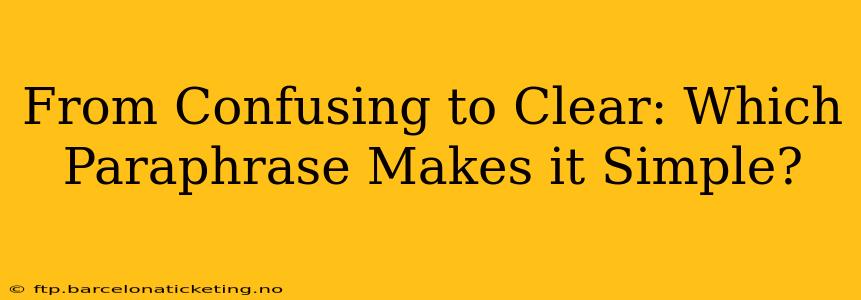Choosing the right paraphrase is crucial for clear communication. A good paraphrase simplifies complex language, clarifies ambiguity, and ensures your message is easily understood. But how do you know which paraphrase is truly better? This post will explore the art of effective paraphrasing and help you identify the clearest and most impactful option. We'll delve into the key elements to consider when evaluating paraphrases and provide examples to illustrate the process.
What Makes a Paraphrase "Simple"?
Simplicity in a paraphrase isn't about shortening the text; it's about enhancing clarity and comprehension. A simple paraphrase:
- Uses familiar vocabulary: Avoids jargon, technical terms, and overly complex sentence structures.
- Focuses on core meaning: Strips away unnecessary details and focuses on the central message.
- Maintains accuracy: Preserves the original meaning without distortion or misrepresentation.
- Flows naturally: Reads smoothly and logically, without awkward phrasing or abrupt transitions.
How to Evaluate Different Paraphrases
Let's consider an example. Suppose the original sentence is: "The ubiquitous proliferation of digital technologies has engendered a paradigm shift in the dissemination of information."
Here are three potential paraphrases:
- Paraphrase 1: "Lots of digital stuff has changed how we share information."
- Paraphrase 2: "The widespread use of digital technologies has led to a significant change in how information is shared."
- Paraphrase 3: "Digital technology's rapid growth has revolutionized information sharing."
Which paraphrase is the simplest and clearest? Let's analyze each:
Is Paraphrase 1 Simple and Accurate?
Paraphrase 1 uses very informal language ("lots of digital stuff"). While it captures the general idea, it lacks precision and might be considered too colloquial for many contexts. Its simplicity comes at the cost of accuracy and formality.
Is Paraphrase 2 Simple and Accurate?
Paraphrase 2 successfully replaces complex vocabulary ("ubiquitous proliferation," "engendered a paradigm shift") with simpler equivalents ("widespread use," "led to a significant change"). It retains accuracy while improving readability. This is a good example of a successful simplification.
Is Paraphrase 3 Simple and Accurate?
Paraphrase 3 also simplifies the original sentence, using strong verbs ("revolutionized") and straightforward language. It's concise and impactful. However, the term "rapid growth" might be considered slightly less precise than the more nuanced phrasing in Paraphrase 2.
The Best Choice: Context Matters
The "best" paraphrase depends on the context. If the audience is highly technical, Paraphrase 2 might be overly simplistic. If the audience needs a quick, easily digestible summary, Paraphrase 3 might suffice. However, for most general audiences seeking clarity, Paraphrase 2 strikes the best balance between simplicity, accuracy, and formality.
Frequently Asked Questions (PAAs)
How do I know if my paraphrase is accurate?
An accurate paraphrase maintains the original meaning, even if it uses different words and sentence structure. Compare your paraphrase to the original: Does it convey the same information? Have you omitted or changed any crucial details? If so, it's not an accurate paraphrase.
What are some common mistakes to avoid when paraphrasing?
Common mistakes include: changing the original meaning, using too many words from the original text without proper attribution (plagiarism), and producing a paraphrase that is too similar to the original.
Is it okay to use synonyms when paraphrasing?
Yes, using synonyms is a helpful technique in paraphrasing, but make sure the synonyms accurately reflect the meaning of the original words.
Why is paraphrasing important?
Paraphrasing is essential for demonstrating understanding, avoiding plagiarism, improving writing style, and making complex information accessible to a wider audience.
By carefully considering these points and practicing, you'll become adept at choosing the paraphrase that best simplifies complex ideas without sacrificing accuracy or nuance. The goal is clear, concise, and compelling communication.

